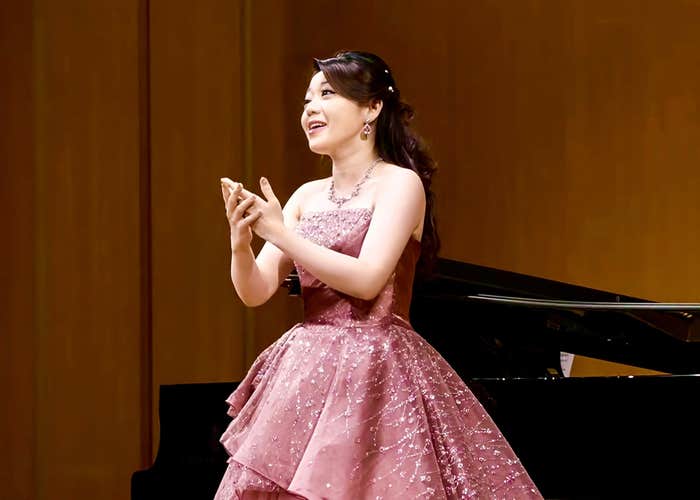This article is part of Nautilus’ month-long exploration of the science and art of time. Read the introduction here.
Growing up in Israel in the 1970s, my household was a place where time and languages were constantly shuffled. Three generations of my family, speaking English, Hebrew, or Arabic, co-mingled and co-existed. Throughout my childhood, we visited two cities weekly, “The City of Gold” (Jerusalem) and “White City” (Tel Aviv). The cities are just 40 miles apart but worlds away. The buildings, monuments, and markets of Jerusalem are a repository of 4,000 years of history, while Tel Aviv is a 20th-century modernist city birthed from the Bauhaus art school. When I was a child, the car ride between those two cities was an excursion, and time seemed to fold in on itself as I moved between two concurrent realities, spanning four millennia in less than an hour.
At an early age, my grandfather planted the seed of nonlinear time in me with a passage from Ecclesiastes: “What is, it already was, and what will be, it already is.” He used this biblical passage to explain the absence of a chronological order in the Torah, and also as an aphorism that reflected his embrace of time—informed by a lifetime of experience and studying sacred text—as a continuous, simultaneous entity. It’s an idea, along with many others from him, that took root in my life and work.
I suspect my conversations with my grandfather resembled the ones he had with my mother 40 years prior. And while one might call this history repeating itself, I think of it as a series of moments that existed outside of time where my mother and I intersected, collectively rather than simultaneously. Our lives would intersect again across time in an unexpected way. Two decades after my mother passed away, I discovered a trove of her teenage love letters, which would inspire my first museum exhibition, Missives , which I’ll come back to later.
The view of an obedient order of time begins to feel archaic, like trying to use an abacus to calculate pi.
Humanity’s default relationship with time seems predetermined as linear. In our lifetime, we travel in a line between two specific points: when we’re born and when we die. In between, we experience a series of events, each following the other in an obedient order, all recorded in a sequential measure of time called the Gregorian calendar, based on the Earth orbiting the sun. Our systems of learning are often codified and contextualized in a specific chronology of past/present, before/after, what was/what is/what is next. That’s especially true in the academic approach to design and art. In school, I was required to memorize “The Timeline of History,” a specific list of events in a linear sequence. As an approach to creative thinking, this fosters a linear trajectory as the path to create something “new” and suggests we move beyond what has been done in the past.
But if one chooses to look beyond the sun as a marker of time, and consider the cosmos as an organizing system of events, our perception can begin to shift from the linear to the infinite—where boundaries are infinitely amorphous, and space as well as time becomes fluid. The view of an obedient order of time begins to feel archaic, like trying to use an abacus to calculate the value of pi.
Among the many wonderful (and eccentric) pearls strung through André Breton’s 1924 Surrealist Manifesto is that creativity is castrated by society’s exorcism of fantastical thinking in children, which begins when they cross the threshold of a school, rooted in rote and rule. But if we allow ourselves to create or entertain a realm where we allow narratives to exist outside logic and consider time as supple or “un-sequenced,” imagination flourishes.
Traditional narratives that have long informed painting and sculpture—such as those drawn from history and the Bible—often depict a specific moment, iconic, yet frozen: an isolated occurrence on a horizontal continuum of time. In the creation of art, I see time as a medium, one that bends, folds, transects, and compresses, creating narratives that transcend their original context and invite the viewer to shift or expand their perspective. Much of my work involves cultural artifacts or sacred texts that have been recontextualized or altered. This interrogation of their forms imbues them with new meaning, one that asks the viewer to question their conventional social and cultural significance as well as their time-infused identity.
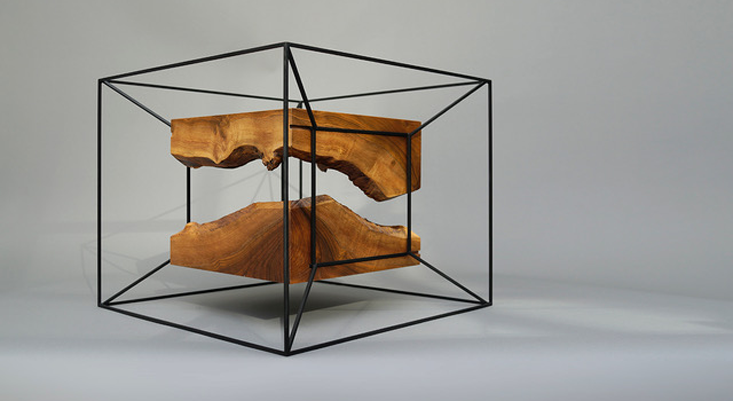
The Hyper Cube
The idea of folding time that I experienced as a child re-emerged in my piece, The Hyper Cube, a sculptural contemplation on the concept of time as the fourth dimension. It’s illustrated by an inner cube and outer cube, each turning inside out/outside in, endlessly trading places, one folding into the other, ad infinitum. A series consisting of four unique pieces, each Hyper Cube is an expression of an arrested moment of time—a cube within a cube—one in blackened steel surrounding one in American black walnut. A single wooden slab from a 250-year-old tree seems to have been folded, origami-like, to form each half of a bisected cube which is surrounded by a steel silhouette of a cube—a juxtaposition of materials separated by more than two centuries. By translating a four-dimensional idea into a three-dimensional object, I wanted to invite the viewer to contemplate our relationship between time and space, and the boundaries of our perception.

The Genesis Series
The pan-spiritual tradition of discussing and contemplating the through-line of iconic narratives of ancient texts (such as Genesis), as a means of illuminating the human condition is a practice that I first engaged in with my grandfather, and still do today.
The Genesis Series, a set of seven assemblage sculptures completed over the past eight years, brings Hebrew biblical text and symbols of the creation narrative into a visual dialogue with vintage scientific apparatus. Each sculpture’s composition is formed by recontexualizing objects, pulled from the spectrum of time and inscribed with their prior existence. Laboratory beakers and tubes dating from as early as the 1940s and 19th-century glass domes—symbols of the empirical world—are engraved with Hebrew text and juxtaposed with Torah finials and crowns from the 18th and 19th centuries. These self-contained universes become unbound from the time-based identity of their disparate elements—formerly points on a linear continuum stretching into the past—as they converge and transform into a metaphorical discourse on the intersection of science and religion, and creation as an ongoing dynamic.
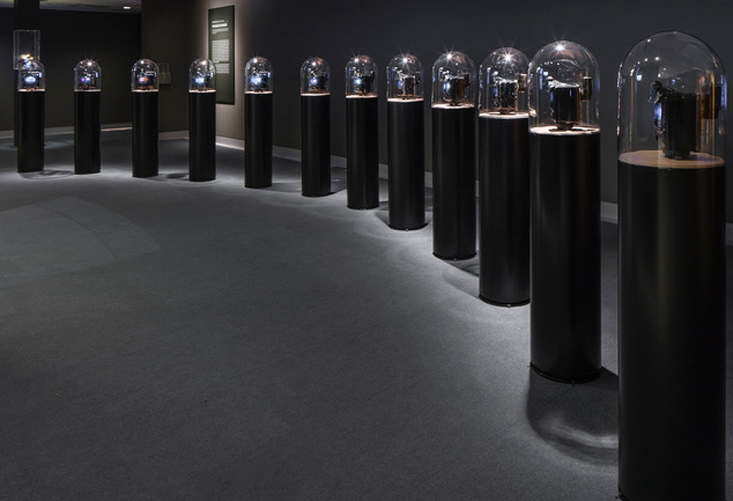
The Road to Sanchi
Deconstructing and melding the narratives, symbols, and rituals of seemingly disparate belief systems—scientific, religious, or social—aim to reveal moments of underlying synchronicity. At this moment in history, as exclusionist movements are gaining traction internationally, it is essential to weave universal threads in cultures, unbound by time, into an alternative narrative.
The Road to Sanchi, a series of sculptures, transforms obsolete taxi meters from India into oculi that observe the collective experiences that unify us, through a prism of time. Exhibited from November 2017 through October 2018 at The Rubin Museum in New York, the sculptures have video screens imbedded in the front and back of the taxi meters which document my auto rickshaw rides over the course of the past 12 years to pilgrimage sites in India for Buddhists, Jews, Hindus, and Muslims. An allegorical reprisal of my childhood car trips, these journeys to the four sites traverse time, geography, and belief systems. The sites include Sanchi, where part of Buddha’s ashes were buried in the third century B.C.; Mattanchery, which has the oldest continuously operating synagogue in India, built in the 1500s; Nizamuddin, the Dargah of a 13th-century Sufi saint in Delhi; and Varanasi, where the Hindu ritual of aarti is performed on the banks of the Ganges every morning and evening.
In all the videos, the destination is never seen—only the road to—centering the emphasis on the journey rather than destination. Each journey surveys the vibrant roadside vernacular that has existed in India for centuries. They record the convergence of pedestrians, markets, and animals with motor scooters and telephone wires—interventions of the modern world. These rides embody the essence of India for me: the intersection of time and a confluence of realities. Each of these is a journey that’s been taken by thousands if not millions of others during thousands of years, and that will continue to be taken. The sculptures ask the viewer to step outside the linear notions of time that dominates so much of our thinking and consider history as the present as well as the future.
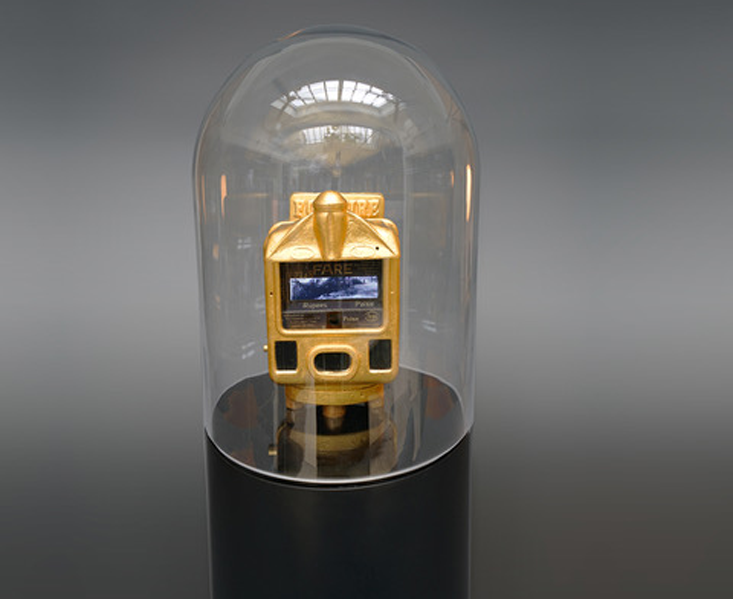
When All Roads Are One
When All Roads Are One, a vintage taxi meter from India—gilded in 23-karat gold to evoke a reliquary—merges the films of the four individual pilgrimage rides into one progressive, yet parallel journey. The films, converted from color to black and white, blur the traditional signals that signify oppositions. Boundaries between day and night, urban and rural, past and present all converge in an allegorical excursion that represents our collective connection to a metaphysical existence—as well as to one another—as an infinite ongoing journey outside of time.
I wanted to capture India’s vibrant roadside vernacular of pedestrians, markets, animals, and motor scooters.
During one of my rickshaw rides in India, the utilitarian function of the meter—which was to measure the time and distance of a journey—took on a new meaning. I saw that it was an object inscribed with the metaphorical energy of thousands of journeys. And now that analogue meters have been replaced with digital versions, they symbolize a specific era of 20th-century India.
With the advent of the digital age, we have become even more obsessed with the “new”—be it an invention, a work of art, a new technology, or the latest cell phone. Our desire to feel that what we are creating or experiencing is something new can be seen as an illusion designed to reassure ourselves that we are advancing. Though are we? I wanted to transform that obsolete, analogue rickshaw meter and channel its metaphorical essence in a non-conventional way that would shift its perception in the eyes of the viewer, and spark a counter-narrative to our preoccupation with the new.
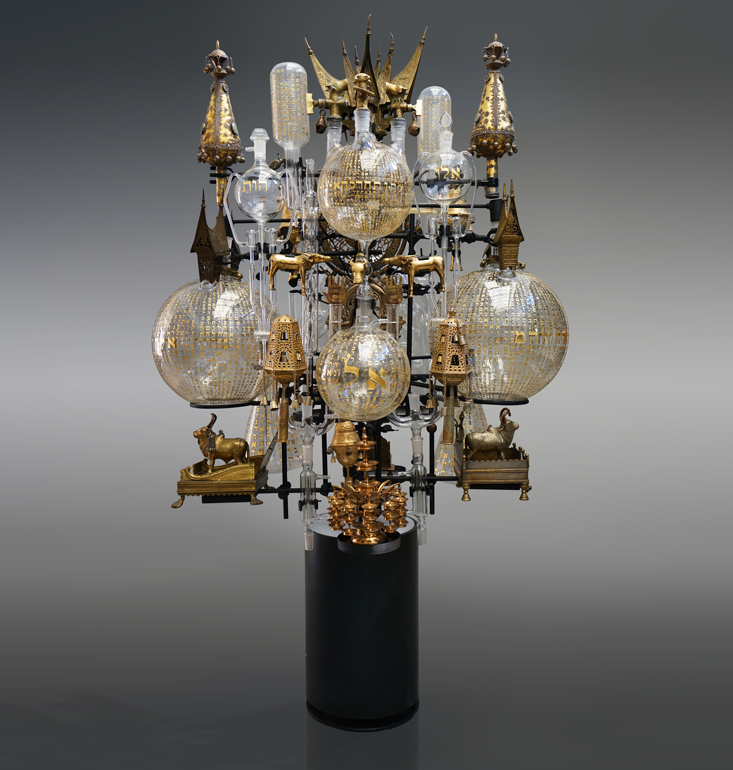
The Immanent Transcendental
Amalgamating a singular narrative that has occurred throughout history also elucidates the discourse on humanity’s interconnectivity—a concept explored in The Immanent Transcendental, an assemblage sculpture that delves into the biblical account of the Golden Calf, the great sin of the Hebrews (as they were called at the time) for worshiping an idol in the desert when they feared Moses would not return from Mount Sinai. Inspired by the medieval scholar Rashi—who wrote the Golden Calf was an expression of the Hebrews’ desire to connect to the divine—The Immanent Transcendental looks at the Golden Calf as a trans-cultural and trans-temporal signifier of humanity’s complex relationship with divinity.
The sculpture combines vintage laboratory equipment, light filaments, vintage glass beakers engraved with the biblical passage, and Rashi’s text in 23-karat gold. It also includes antique and vintage golden icons and symbols from numerous belief systems and eras. The veneration of the calf/cow/bull threads from early Native American culture to Mesopotamia through South Asia; chronologically, it prevails from prehistoric times to present-day India, where Nandi, the vehicle of the Hindu god, Shiva, is revered as a connection to the divine.
By detaching these symbols from time and context and reassembling them, the relevance of which came “first” falls away. The sculpture becomes a symbiotic realm of otherness and sameness, a metaphorical expression of humanity’s collective desire to exist within a metaphysical/spiritual realm that is simultaneously singular and multitudinous, without beginning and without end.

Parting Waters
Vintage wooden crates from the 1920s, containing slender-necked beakers used to verify if milk was being diluted with water, became the catalyst as well as the vehicle for examining parallel narratives in Parting Waters, a sculpture that explores the journey to freedom described in Exodus as it transects with the present—and the energetic essence of physical and metaphysical liberation.
The movement from one state of being to another—from the Hebrews escaping enslavement through a parted Red Sea to the contemporary flight of Syrian and African refugees journeying through the Mediterranean—is often via water: the essence of life, a vehicle of catharsis, the signifier of a new state of existence.
The 72 beakers in the sculpture—each inscribed with one of the 72 names of God, which, in the Kabbalistic interpretation of Exodus, Moses recited in order to part the Red Sea—form a symbolic pathway to freedom for a procession of figures. While they could represent either the Hebrews or present-day refugees, each figure is painted black, blurring the specificity into a universal human desire for liberation—be it from social oppression or to transcend the limits of our own consciousness.

GER/The Stranger
GER/The Stranger commemorates the 500th anniversary of the Jewish ghetto in Venice, Italy, and simultaneously considers the events of 1516 in a pan-temporal context. GER was conceived as parallel in both form (a main axis of two glass spheres) and content in which the larger, enduring struggle of humanity’s relationship with otherness—a swinging pendulum of repression, which is looming again on the forefront of our contemporary socio-political landscape—is presented with an alternative narrative inspired by the life of Maimonides (Rambam), the seminal medieval Jewish philosopher, scholar, and physician.
With Jewish, Muslim, and Christian religious iconography and two nearly identical glass spheres—separate, yet conjoined by 19th-century Torah finials from Yemen, the country of my ancestry—GER evokes the parallel existence of the Jews, the ultimate “other,” whose diaspora threw them into an oscillating spectrum of tolerance and tyranny. The sculpture’s totemic, hourglass shape conveys a continuum of time, one that endlessly turns and repeats, signifying that the codification of the Jews, or any population as “the other,” is a narrative both older and more recent than the World War II genocide, 19th-century pogroms, the establishment of the first Jewish Ghetto in Venice in 1516, or the persecution of Jews in the early part of the Middle Ages.
Sacred text engraved on the sculpture’s glass beakers in Hebrabic/Arabrew—a melding of Hebrew and Arabic phrases that I created in 2010—form a metaphorical parallel to Maimonides: a contemporary exploration of traversing the cultural chasm of otherness. The intertwining languages also invite a point of contemplation. Though these two cultures have become disparate in our contemporary existence, with compassion, there is a parallel narrative where contrasting ideologies have the potential to co-exist. In the impending global shift toward exclusion and segregation, the axis of light traversing the glass spheres evokes humanity’s connectivity.
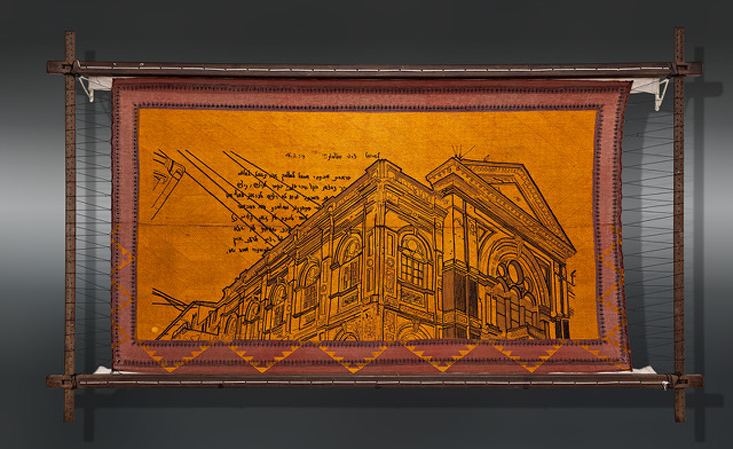
Missives
As I mentioned earlier, my mother’s past intersected with my present life a few years ago, when I was in my early 40s. This time it became art. Missives, my first museum exhibition, at the Dr. Bhau Daji Lad Museum (formerly known as the Victoria and Albert Museum) in Mumbai, was inspired by the love letters she wrote in the 1950s. They came into my possession in 2010, nearly 20 years after she had passed away at an early age in 1993. Those letters, seemingly a record of a precise moment in time and forgotten in an attic for over 50 years, recount her side of an unrequited teenage love affair, and are steeped with the universal and sometimes conflicting desires of young love. Reading those letters for the first time when I was in my early 40s, I entered her vividly described world, ricocheting in time, and discovered my mother as a keenly aware teenage girl in the 1950s, who wanted to love and be loved without the constrictions inherent in the expectations of a traditional conjugal relationship.
Although my approach is to plumb history, artifacts, and sacred text as a way to question and inform our existence—such as the antique Judaica or the vintage Indian taxi meter—reincarnating them without sentimentality allows their resonance to transcend their former identity as well as any specific moment, which is certainly part of what my grandfather was imparting to me with Ecclesiastes.
My first museum exhibit was inspired by a trove of love letters written by my mother as a teenager.
After reading my mother’s letters over and over, I was able to detach my emotions, and appreciate what I was reading as an experience that also existed beyond my mother’s, as a collective memory. If the time, the place, and my mother’s emotions were exorcised, the narrative was part of a universal landscape of desire and memories of many women throughout time. When my mother passed away, I saw it as a sort of end point in the extraordinary relationship we shared, but when I received those letters, it was as though she had written them to her unborn son—delivered through a circuitous channel of time—and we began a new conversation.
The centerpiece of Missives was a series of phulkaris: antique shawls from India that were embroidered by teenage girls as part of their wedding dowry and given to their mother-in-law on their wedding day. I had passages from my mother’s love letters embroidered on them, along with my drawings that responded to what I read in her letters, so the works became metaphorical conversations between two girls who lived 200 years apart—with two very different points of view about marriage—that transcend time, culture, and geography, with myself as an intermediary.
By connecting these porous fissures in the strata of time, the work is both old and new, which liberates the boundaries of the viewer’s engagement. Re-codifying the specific—be it my mother’s love letters, rickshaw rides, sacred text, or golden icons—conjures an amorphous dimension where viewers can enter into a conversation with time that is fluid rather than linear. They can explore a dialogue that energetically interconnects cultures, experiences, and humanity in a reality that is simultaneously the past, the present, and our future.
Ghiora Aharoni, a graduate of Yale University, founded his multi-disciplinary studio in Manhattan in 2004. His artwork and designs have been exhibited in New York, Europe, Israel, and India. His work is in the permanent collection of The Pompidou Center in Paris, as well as private collections in the United States, Europe, Canada, and India. His solo museum exhibition, The Road to Sanchi, is on view at the Rubin Museum in New York through October 2018. His sculptures will be shown in museum exhibitions opening in Vienna in October 2018 and in Amsterdam in March 2019.
Lead photo: Copyright © David de Armas Photography 2017





























